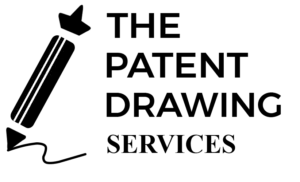A design patent provides the protection on the aesthetic design of a device and are fully well-defined with line drawings representing the device. The Design patent in comparison to a utility patent is simple and less hectic job one can avail. The most important aspect of a design patent is the drawings. USPTO recommends 7 standard views for a design patent application that will cover complete protection of the invention. Those 7 views may be of the following: 3D/isometric, top, front, left, right, bottom, back. However, the number of views can be increased if the product consists of more than 1 embodiment. For example, an article is made up of 3 embodiments then the number of will be 3 (embodiments) X 7 (views) =21. Also, it is advised that Birdseye/perspective views/drawings be submitted to visibly show the overall look and shape of 3 dimensional designs. If a perspective view is submitted, the surfaces shown would normally not be required to be illustrated in other views if these surfaces are clearly understood and fully disclosed in the perspective.
A design patent application may only have a single claim (37 CFR § 1.153). Designs that are independent and discrete should be filed in separate applications since they cannot be reinforced by a single claim. In order to get a design patent one must get the drawings prepare by a professional drafting company such as “The Patent Drawing Services”. To be specific, the game of getting a design patent is through a quality formal drawing with appropriate shading and consistency. Also, the drawing disclosure is the most vital part of the application. Every design patent application must include formal drawings of the claimed design. As the drawing constitutes the full visual disclosure of the entitlement, it is of extreme importance that the drawing be clear and complete, that nothing regarding the design pursued to be patented is left to speculation. The design drawings should comply with the disclosure necessities of 35 U.S.C. 112. To meet the requirements of 35 U.S.C. 112, the drawings or photographs must include enough number of views to institute a complete disclosure of the appearance of the design claimed. Similarly, the most effective way to avoid claiming a particular design feature or element is to show such feature in broken or dashed lines.
Further, views that are merely duplicates or mirror images of other views of the design may be omitted if the specification makes this explicitly clear. For example, if the left and right sides of a design are identical or a mirror image, a view should be provided of one side and a statement made in the drawing description that the other side is identical or a mirror image (i.e., “the right side elevational view is a mirror image of the left side”). If the bottom is flat and includes no ornamentation, that view may be omitted if the figure descriptions include a statement explaining the view (e.g., “the bottom is flat an unornamented”). “Unornamented” should not be used to describe visible surfaces that clearly are not flat. The most effective way to avoid claiming a particular design feature or element is to show such feature in broken or dashed lines.
Filing Requirements for Design Patents
There are several components to a design patent application, though the bulk of the preparation time will typically centre on the drawings section. The main elements are:
- Drawings
- Preamble, stating applicant’s name, title of the design, brief description of the drawings and intended use of the article on which the design is embodied
- Cross-references to any related patent application(s)
- Statement regarding any federally sponsored research and development, or funding
- Full description of drawings
- Figure description
- A single claim
- Executed oath or declaration
Drafting claims is typically the most laborious and important element of a non-provisional patent application. However, only one claim is required for a design patent application. Again, the USPTO considers the best “description” of the invention to be the drawings themselves, so the claim drafting takes a backseat in design patent applications.
Information Disclosure Statement
During the application process, you may choose to file an Information Disclosure Statement (IDS). This document notifies the Office of any related “prior art” you know of to aid the examiner in the review of your application. Prior art generally includes patents, publications or information within the public domain which relates to your design. The USPTO will still conduct a search but filing an IDS can help speed the review period. Thus, if you are aware of any prior art, you should submit an IDS within three months of your design patent application filing date. If you want expedited review of your application, an IDS is required, along with other items and an additional fee. We can help with expedited processing of your design application.






